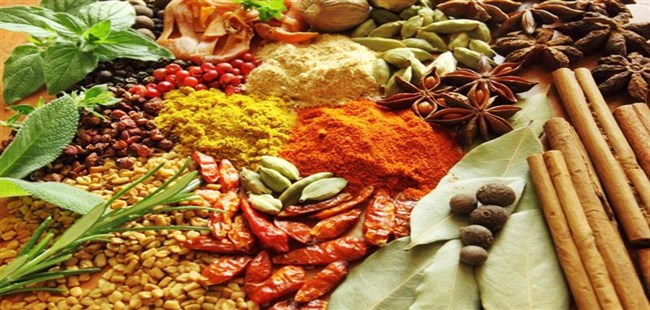It is well worthwhile having a good selection of dried herbs and spices on hand to add flavor to all kinds of everyday dishes. Bear in mind that many dried herbs have a limited shelf life and should be used within six months.
Most herbs store successfully in dried form, and there is a wide range of commercially dried herbs to choose from. Freeze-dried herbs retain their color and are therefore visually more attractive than traditional dried herbs, but they are usually a little more expensive.
Buying Dried Herbs
• Choosing jars: When buying herbs packed in jars, choose jars that have a good, airtight seal. Herbs retain their flavor best if stored in either screw- top or flip-top jars, both of which are more securely airtight than jars with corks.
• Buying whole-leaf herbs: If possible, choose whole-leaf dried herbs such as rosemary or bay. Dried herbs that have been crushed or ground are likely to lose their flavor much more quickly than those whose leaves are left whole.
Storing Herb Jars For Easy Access
Using drawer space: Herbs and spices are best stored in a dark place such as a cool kitchen drawer. Keep small jars flat and tidy the herbs and spices will be easy to select since you can see the contents or labels of each jar at a glance.
Drying & Storing Herbs
1. When drying herbs such as sage, thyme, or parsley, keep the leaves on the stems until completely dry. Rub the stems gently between your fingertips, crumbling the leaves into a small bowl. Discard stems, or use to flavor stocks.
2. Put some of the crumbled leaves into small containers such as test tubes, using a piece of paper to funnel the herbs in gently. Keep the containers in a rack ready to use in cooking. Store any remaining herbs for future use.
Storing Dried Herbs
• Keeping the light out: Store dried herbs in airtight glass containers, and keep them in as dark a place as possible.
• Extending storage life To prolong the lives of dried herbs, wrap them tightly in plastic bags. Keep the herbs in the refrigerator for three months, or freeze for up to six months.
Noting storage times write the purchase dates of dried herbs on pieces of masking tape, and stick these on the bases of the containers. Alternatively, use a felt-tip pen to write the dates on the jars.
Arranging alphabetically If you have a large selection of herb containers, arrange them in alphabetical order so that you can find the herbs you need quickly and easily.
Herbs, Spices, And Seasonings
Spices: Spices, like herbs, need careful storage away from light and heat, both of which shorten their shelf lives. Spices keep their flavor best when stored whole, so it is best to grind them as you need them or to store ground spices in small amounts and use them within a short time.
Choosing Whole Spices
• Selecting seeds: Check that whole seeds such as caraway or coriander have a uniform shape and consistent color, with no stem or chaff content.
• Checking cardamom: Buy whole cardamom pods that are pale green, plump, and unblemished. The seeds inside should be black or brown, and slightly sticky.
• Buying cinnamon: Choose slim cinnamon sticks with an even, pale, soft brown color.
• Choosing cloves: Look for whole cloves that are large, plump, and oily, with a warm, reddish-brown color.
• Testing beans for freshness: Bend the vanilla beans. They should be supple and resilient.
Useful Spices
Keep a selection of basic spices in your cabinet.
• Black peppercorns: Crush coarsely for spiced coatings.
• Nutmeg: Always grate fresh nutmeg since the ground spice loses flavor quickly.
• Cinnamon: Keep cinnamon sticks and the ground spice for versatility in your cooking.
• Coriander and cumin: These are useful ground spices to add to many ethnic dishes.
Using Mustards
Mustard powder: Add a little mustard powder, which acts as a preservative, to mayonnaise and other dressings to prolong their shelf lives, and to add a sharp flavor to the dressings.
Making mustard
Crush white and black mustard seeds together, and mix to a paste with wine vinegar. Add honey and flavorings such as chilies to taste. Keep in a screw-top jar.
Preparing Spice Mixes
Making cinnamon sugar Mix:1 cup (225 g) superfine sugar with a tablespoon (25 ml) cinnamon. Store in a shaker, and sprinkle on warm buttered toast.
Making Pie Spice
Make your own favorite mixture of spices, such as sweet mixed spice for harvest-time baking. Grind together whole cinnamon, nutmeg, and cloves, or allspice; add a pinch of ginger. Store the mixture in a small, screw-top jar.
Grinding Whole Spices
Using a coffee grinder: Grind your own whole spices in an electric coffee grinder to make a spice blend in seconds. Use a pastry brush or paper towel to clean the grinder thoroughly immediately after use, removing any lingering spice flavors.
Keeping Flavors
• Using spices quickly: Ground spices lose their flavor and aroma quickly, so buy only a small quantity at a time, and make sure that you use it up within six months.
• Choosing chilies: Choose red chilies, which are simply ripened green chilies, rather than green chilies if you want a sweeter flavor. Select yellow caribe chilies for a sweet, mild flavor green jalapeno chilies, which are the most common type, for average heat and orange habanero chilies for a hot and distinctive fruity flavor. Experiment with other varieties to find your favorites. % Toasting whole spices To get the most intense flavor from spices, toast them whole in a heavy, dry frying pan. Shake the pan over fairly high heat for a minute or two, and use immediately.






